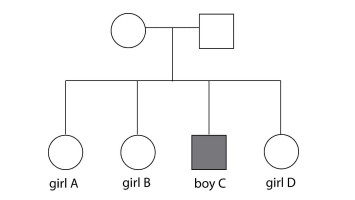The family pedigree shows that boy C has a genetic condition. No other member of the family shows the same genetic condition.

Which one of the following could NOT explain why boy C has the condition?
A. Sex-linked dominant condition
B. Sex-linked recessive condition
C. Both parents are carriers
D. Autosomal recessive condition
E. Mutation
1 Like
The answer to this question is choice A.
Before we rationalize the answer, let’s establish an important concept, sex chromosomes.
- Males have XY sex chromosomes. (Males inherit the Y chromosome from the father, and the X chromosome from the mother.)
- Females have XX sex chromosomes. (One from each parent.)
Let us then begin dissecting choices B- E to see why they are compatible with the diagram given:
-
Choice B: Sex-linked recessive condition: This scenario is possible given the clues the pedigree gives you. None of the siblings (that have the sex chromosomes XX, since they are females) express the condition, meaning that the condition must be a recessive trait. What will make you think that it is a sex linked recessive trait? Remember that males have XY sex chromosomes. Thus, regardless if the trait is dominant or recessive, ANY x-linked condition WILL be expressed in males. However, you can infer that this is not an x-linked dominant condition since NONE of the sisters express the trait. Since they have XX sex chromosomes, a dominant x-linked trait WILL be expressed, but a recessive trait will NOT. Therefore, a possible explanation would be that the trait is expressed on the X chromosome of the male is recessive one, which was inherited from his mother, a carrier (males inherit the Y chromosome from the father). The fact that the mother also does not express this condition is another statement in support that this is indeed a recessive condition, since she has XX sex chromosomes. This then, supports that choice A is the answer, since it is not possible that it was an X-linked dominant condition since again, none of the siblings, nor the mother, express the condition.
-
Choice C: “both parents are carriers” & Choice D: “autosomal recessive trait”: This is also a possible explanation, if you consider mendelian inheritance. Both choices are combined in this explanation, since you can only have an offspring express an autosomal recessive trait if both parents carry a recessive allele, in other words, have a heterozygous genotype. This will be best explained if we use an example. Imagine that both parents have the genotype Aa. If you plot this on a punnett square, there are 4 possible genotypes for the offspring: AA, Aa, Aa, and aa. Thus, there is a 75% chance for an offspring to present with the phenotype expressed by the A allele, and a 25% chance for an offspring to present with the autosomal recessive condition expressed by the a allele. Thus, it is possible for an offspring to inherit an autosomal recessive condition if both parents are carriers.
-
Choice E: mutation: It is also possible that the genetic condition rises from a sporadic genetic mutation, wherein none of the parents have any inheritable conditions. These could be attributed to alterations in the child’s DNA due to various errors during DNA replication.
3 Likes
When the alternative says “dominant” or “recessive” do I need to think about chromossome X? Or I need to think about chromossome Y too?
If there was an alternativa saying about chromossome Y, what would be? “Holandric condition”?
